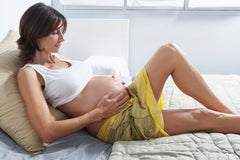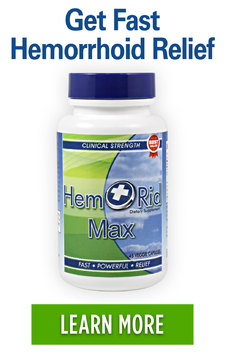Postpartum Hemorrhoids Help - When Postpartum Hemorrhoids Won't Go Away
Posted on 19 June 2018 by Maryanne Johnson
Share this post
In this Postpartum Hemorrhoids Guide, we'll discuss why you get hemorrhoids during a pregnancy and what you can do to get maximum relief.
Hemorrhoids are not often discussed but are a frequently occurring problem for expecting and new mothers as well as for older adults, men, and women alike.
Pregnancy hemorrhoids can happen at any point throughout the trimesters, but symptoms tend to worsen as a woman becomes closer to her delivery.
Potential causes of hemorrhoids:
- Age
- Pregnancy/postpartum
- Constipation
- Sitting or standing for long periods of time
- Lack of water or exercise
- Lack of dietary fiber
- Lifting heavy objects frequently
- Straining during bowel movements
The reason being is that with the ever-expanding uterus during pregnancy, the lower rectal area experiences a growing amount of pressure on its tissues, muscles, and rectal passage.
Constipation is another variable that has an increased presence during pregnancy. Straining and hardened stools aggravate hemorrhoids, causing increased inflammation and worsening symptoms of hemorrhoids.
There are two different types of hemorrhoids—internal and external, and both types can occur during pregnancy and postpartum. Internal hemorrhoids are painless and cannot be seen or felt unless a prolapse takes place. External hemorrhoids are swollen bumps around or on the anus.
All About Hemorrhoids After Birth
Straining and pressure are the common factors behind inflammation of rectal blood vessels and veins, resulting in hemorrhoid symptoms like itching, pain, discomfort, and a burning sensation.
Vaginal delivery, however, is a big reason why women experience hemorrhoids directly following the birth of their babies.
With a vaginal delivery, hours of intensive labor is typically involved. Pushing, straining, and pressure is all at work and frequently result in these sensitive rectal veins becoming swollen. External hemorrhoids will form soon after because of the severity of straining for long periods of time.
External or internal hemorrhoids may already be present before delivery. Pregnancy, especially during the final trimester, puts additional pressure on the lower rectal muscles and tissues that can lead to inflammation. Hemorrhoids are apart of general pregnancy issues.
Vaginal delivery can make hemorrhoids flare-up again or worsen already present symptoms.
Sometimes, internal hemorrhoids can prolapse during vaginal delivery or afterward. While internal hemorrhoids are typically painless and can only be noticed by occasional rectal bleeding, these hemorrhoids can extend past the rectum.
However, hemorrhoids are by no means a fatal condition. Everyone has hemorrhoids, as they are the clusters of veins and blood vessels inside the rectum and beneath the skin surrounding the anus.
Hemorrhoids after vaginal delivery can go away on their own, but with remedies and treatments, they can be encouraged to shrink faster and aid in alleviating symptoms.
Hemorrhoids After a C Section
Just because a cesarean section has been performed does not mean that hemorrhoids cannot happen.
Some mothers in the midst of labor still experience intense straining before delivery via C-section, and this can cause hemorrhoid swelling.
Constipation is an issue widely experienced by new mother, regardless of delivery method. For women who are recovering from a C-section, they may notice external hemorrhoids surrounding the anus, which are small bumps, rubbery to the touch.
External hemorrhoids are often a result of straining brought on by constipation.
In many cases, a C-section is performed due to severe hemorrhoids. Hemorrhoids tend to worsen as the expecting mother’s due date grows closer.
The bigger the uterus becomes, the more pressure is placed on the rectal veins and in turn, they become swollen, producing the symptoms of hemorrhoids.
Thrombosed hemorrhoids are a more severe form of external hemorrhoids and sometimes when they are present in the anal area during labor, doctors will opt to perform a cesarean to prevent them from rupturing during delivery.
Thrombosed hemorrhoids are external hemorrhoids that have a blood clot form and become trapped in the cluster of vessels and veins. These hemorrhoids are painful and can make every movement uncomfortable.
Hemorrhoid doctors don’t want to see their patients struggle with unneeded discomfort during the already painful delivery process or put them at risk for an infection if the clots rupture.
Some women may also experience internal hemorrhoids after a C-section is performed. Internal hemorrhoids are painless, fortunately, and so is the bleeding that can happen after a bowel movement or visibly seen on stools.
Like hemorrhoids that occur after a vaginal delivery, any hemorrhoids that are present after a C-section will go away on their own. For external hemorrhoids, home remedies and topical treatments will encourage them to disappear more quickly and also make any pain, swelling, itching, and burning subside temporarily.
When do Postpartum Hemorrhoids Go Away?
As with any other condition, it the answer is that postpartum hemorrhoids go away in a different time span for everyone. Typically, external and internal hemorrhoid symptoms and inflammation will subside in a few days or a couple of weeks.
Whether the delivery was vaginal or a C-section, the delivery process is stressful on a woman’s body.
Pushing and straining make hemorrhoids worse, inciting further inflammation of the rectal veins and blood vessels.
Symptoms of postpartum hemorrhoids include:
- Hemorrhoidal Bleeding
- Blood in Stools
- Little bumps in the anal region
- Itching and Irritation
- Stinging and Burning
- Pain and Agony
For postpartum hemorrhoids shrinkage, there are many options you can try at home. Topical creams, ointments, wipes, and balms are all popular methods for at-home solutions in relieving hemorrhoid pain and encouraging faster shrinkage.
Doctors recommend sitz baths as one of the most effective methods in shrinking and relieving hemorrhoids and their symptoms. By immersing the lower half of the body in a tub of warm water, explicitly submerging the hemorrhoidal area, swelling and inflammation can be reduced.
Drug stores and other superstores carry topical treatments for postpartum hemorrhoids, from Preparation H creams to wipes with witch hazel and other natural ingredients.
Doctors advise their patients experiencing postpartum hemorrhoids to add more fiber into their diet through whole foods like fruits, vegetables, whole grains, nuts, and beans.
When patients struggle with including fibrous foods into their diet, fiber supplements can be added to prevent constipation, hardened stools, and straining.
Although exercise is recommended to quicken the shrinkage of hemorrhoids, new mothers should refrain from engaging in strenuous activities and vigorous exercise directly after giving birth, for both vaginal and C-section deliveries.
But with an occasional brisk walk and by wearing loose fitting clothes, postpartum hemorrhoids and symptoms should subside.
What to do When Postpartum Hemorrhoids Bleed
While rectal bleeding can be unsettling to see, new mothers should know that with postpartum hemorrhoids, this is a common occurrence. Bleeding can take place with internal and external hemorrhoids.
External hemorrhoids become aggravated during delivery with the strenuous pushing from labor, and this can result in blood clots forming inside of the swollen blood vessels or veins.
Bleeding can happen if the lump is ruptured. If this happens, patients should inform their doctors to prevent infection on this open wound.
Internal hemorrhoids painlessly bleed, and you will notice this after a bowel movement. Sometimes, bright red blood will cover stools. This is normal, but you should let your doctor know just in case further examination is required.
What to do About Postpartum Hemorrhoids That Won’t Go Away
Stubborn postpartum hemorrhoids that don’t go away could require a more serious approach, like band ligation, sclerotherapy, or hemorrhoid surgery to eradicate them.
Invasive surgeries are usually last resort methods.
Hemorrhoids will shrink more quickly when fiber is included in the diet. With softer stools that hold bulk and moisture, you are less likely to strain while passing them. Fiber is an excellent prevention method for internal and external hemorrhoids.
For postpartum hemorrhoids, your doctor may also prescribe a stool softener if you are having difficulty in getting them to go away.
If you do decide to strive for a more fibrous diet, then be sure to drink plenty of water. Drinking at least 8 ounces of water throughout the day for postpartum hemorrhoids will help your stools soften.
If you have postpartum hemorrhoids that are reoccurring or don’t seem to go away at all, then by speaking with your doctor, you can be advised as to which treatment method is right for you.
It could just be a change of diet to include a fiber supplement, drinking more water, or a topical cream your doctor recommends.





0 comments